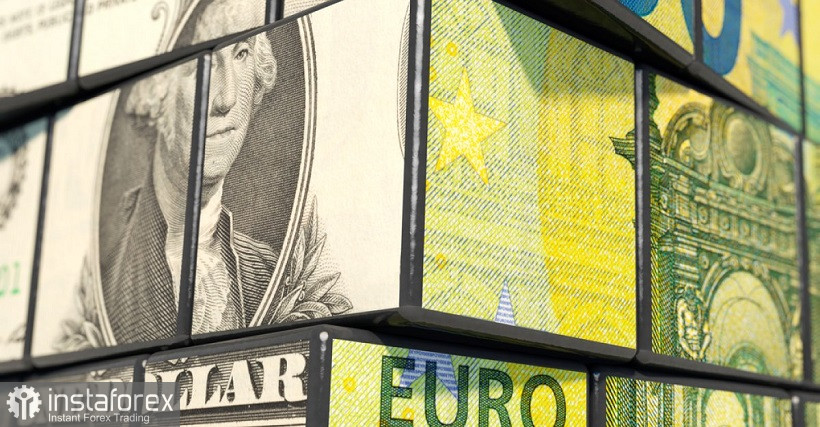The euro-dollar pair tested the resistance level of 1.0670 on Monday, which corresponds to the middle line of the Bollinger Bands indicator on the D1 timeframe. Bulls were supported by European Central Bank President Christine Lagarde, who voiced hawkish comments on the prospects for monetary tightening. In addition, German IFO indices unexpectedly ended up in the green zone. These factors allowed EUR/USD bulls to show their temper, especially against the backdrop of a general weakening of the US currency.

Last week the EUR/USD bulls were gradually approaching the borders of the 6th figure. Having tested the level of 1.0600, they were forced to retreat - the so-called Friday factor played its role. Traders took profits on long positions, putting background pressure on the pair. But bulls have become more active again. This is partly due to the temporary weakening of the greenback, partly due to the strengthening of the European currency. Dollar bulls vitally need additional information feed, as they have already won back many fundamental factors. In order to hold their positions (not to mention a decline to the area of 3-4 figures), EUR/USD bears need new, more powerful signals of a fundamental nature. In the information vacuum, the dollar bulls were forced to give up the initiative to their opponents. This situation has developed in almost all pairs of the major group. The euro-dollar pair is growing most actively due to the hawkish messages of the head of the ECB, as well as due to the already mentioned IFO report.
Lagarde tightens her rhetoric from speech to speech, thus supporting the "hawk wing" of the ECB, whose representatives insist on raising rates already at the July meeting. She specified the scenario for tightening monetary policy. According to her, the ECB may increase the deposit rate to zero by the end of September, "after which further increases are possible." This means that the ECB will raise rates following the results of the July meeting, as well as in September, after assessing the dynamics of inflationary growth in the euro area.
It is worth noting that the ECB has not raised interest rates for more than ten years, so the corresponding signals on this matter excite the minds of EUR/USD traders. Moreover, these are far from the first messages of this nature. During the previous two weeks, other representatives of the regulator made similar statements. For example, the head of the Bundesbank, Joachim Nagel, said on Friday that "negative interest rates are a thing of the past." The head of the Bank of France, Francois Villeroy de Galo, also spoke in favor of an early rate hike. A similar position was voiced by Madis Muller and Martins Kazaks. The chairman of the central bank of the Netherlands, Klaas Knot, called for an increase in rates by 50 basis points at once. But the rest of his colleagues are not in a hurry to talk about what steps they are ready to take to tighten monetary policy. Even Lagarde said that she can't comment on Knot's idea right now: according to her, she shares his line of thought, however, in her opinion, economic growth still cannot be risked.
But in general, we can draw a fairly unambiguous conclusion that the ECB will support a 25-point increase in rates in July and September. Now even some doves make it clear that they are loyal to this idea. Among them are ECB Chief Economist Philip Lane and Executive Board Member Fabio Panetta.

Also, the European currency received support from the IFO reports. The German indicator of economic expectations, contrary to recession forecasts, rose to 86.9, despite the impending energy crisis and geopolitical tensions. The business environment indicator also came out in the green zone, being at around 93 points (the best result since February this year). Commenting on the published data, an economist at the IFO Institute said that there are "no signs of a recession in Germany at the moment", stressing that the country's economy is "stable". It should be recalled here that the latest ZEW reports also came out in the green zone. In particular, the German economic sentiment index improved to -34.3 in May, beating forecasts.
It should be noted that all of the aforementioned fundamental factors will not be able to turn the tide on the EUR/USD pair fundamentally. But "in the moment" they play their role, justifying the corrective upward rollback. In other words, bulls took advantage of the temporary weakening of the greenback, which won back the Federal Reserve's hawkish comments and found itself in an information vacuum. Statements by the ECB representatives and good numbers from the IFO added to the picture, allowing the EUR/USD bulls to approach the resistance level of 1.0670. However, at the moment, the pair has not been able to overcome this price barrier, let alone go above 1.0700. This is a wake-up call for the bulls - if the price fails to consolidate above 1.0670 within the next 24 hours, bears can seize the initiative again, pulling the price into the area of the 5th figure.
Thus, at the moment it is advisable to take a wait-and-see position for the pair. Apparently, the corrective growth of the pair has not yet been completed (that is, short positions are risky), while bulls are clearly giving up near the middle line of the Bollinger Bands on the daily chart (ie, longs also look dangerous). In my opinion, within the next 24 hours the pendulum will swing in one direction or another: either the bears will go below 1.0600, or the bulls will try to test the 1.0700 target.
 English
English 
 Русский
Русский Bahasa Indonesia
Bahasa Indonesia Bahasa Malay
Bahasa Malay ไทย
ไทย Español
Español Deutsch
Deutsch Български
Български Français
Français Tiếng Việt
Tiếng Việt 中文
中文 বাংলা
বাংলা हिन्दी
हिन्दी Čeština
Čeština Українська
Українська Română
Română

